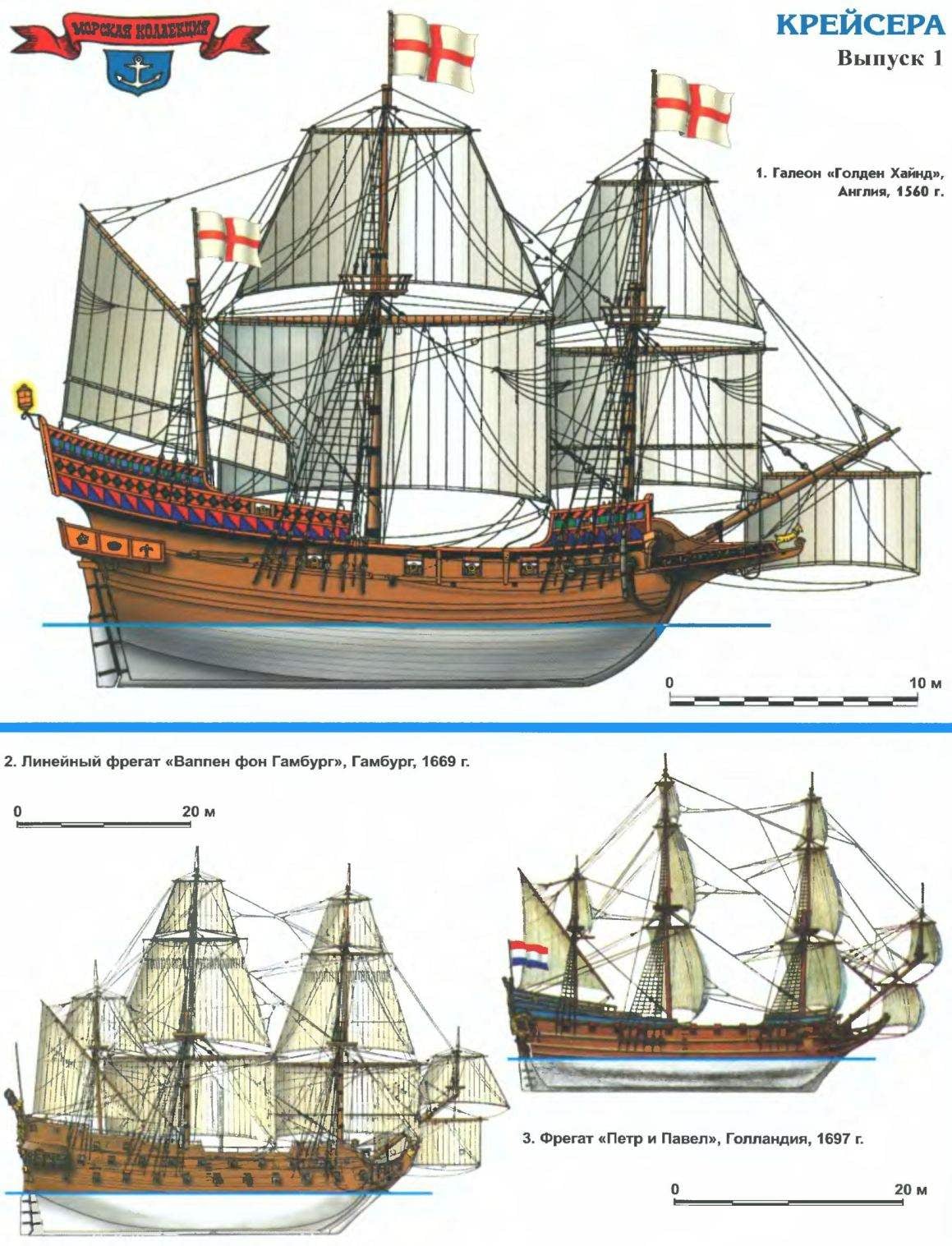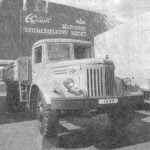 Cruiser… If you ask a contemporary, not too close to the history of the Navy with what he associated that word is likely to hear in response the power and speed to Do in the last decades of its existence, the cruiser has firmly taken the place of the main class of surface warships, inferior in strength and value, except that the aircraft carriers. But the path to this state of was very long and difficult.
Cruiser… If you ask a contemporary, not too close to the history of the Navy with what he associated that word is likely to hear in response the power and speed to Do in the last decades of its existence, the cruiser has firmly taken the place of the main class of surface warships, inferior in strength and value, except that the aircraft carriers. But the path to this state of was very long and difficult.
In a new series of articles we will try to reveal all the details of the occurrence, development and changes of the cruisers — ships that have left an important mark in the history of the fleets of most Maritime powers and the war at sea. As a purely naval architecture aspects of combat ships of this class, as perhaps no other, closely related with politics and Economics, special attention will be paid to these issues as needed, in our view, are the descriptions of the fighting cruisers and assessment of their effectiveness, because the effectiveness of combat use is the basis and justification for the construction of these “hunters and hunters for hunters”.
Their appearance of the cruiser owing solely to the Maritime trade. Already somewhat worn from frequent use of the expression “the sea is the cradle of mankind” still remains true. For many centuries the use of the seas and oceans for transportation of goods provided undeniable benefits. Even now, despite the full and is clearly advancing the development of other modes of transport, the transport of one tonne of goods by sea is several times less than by rail or road, and in the tens or even hundreds of times cheaper than by air. Especially preferred was the waterway in the past century and Millennium, when in the absence of planes, helicopters and vehicles, Maritime transport was still the fastest, especially at large distances. So for a long time did not trust the words of the famous British privateer and Admiral W. Raleigh: “whoever owns the sea, owns the world’s trade. And who owns the world manufacturing, owns the wealth of the earth and by itself”.
It is clear that the possession of the sea was challenged at the first opportunity. And not only the powers of the rivals in the scale of seas and oceans, but also of individual “entrepreneurs”, seeking to profit from the seizure of another’s property. The sea bandits pirates since antiquity acted hardly probable not on a large scale than their land counterparts.
The real heyday of Maritime trade associated with the use of sails as the main propulsion of ships. Sails were given unlimited opportunity to move away from the coastline, to cross the seas and oceans, reported vessels have seaworthiness and autonomy depend on the food and water that can be taken on Board. If the size of rowing boats was mainly determined by the location of the rowers and oars, the value of sailing ships was dictated almost exclusively by the material of their shells. However, the use of wind energy strongly depended primarily on the weather. In dead calm rowing the ship could get (and got) a distinct advantage, if he needed to get away from the sailboat or to catch up with him. So for a long time, the military court remained a row, while trading before they moved on to the sails, which, among other things, was many times more economical.
However, from the attack in the open sea, the sailboat could protect themselves only. So trade ships had to have weapons to defend themselves in battle with pirates or warship of an enemy country. This situation was most acute in the era of the Great geographical discoveries, when karakki and Galleons, transporting across oceans precious cargo, became a desirable and seductive production. This forced them to be in constant readiness to defend themselves from attacking ships, similar in size and armament.
For many centuries, a clear distinction between commercial and military courts were virtually absent. So, the first military sailing ships Mediterranean sea — Coggi — served and “traders”, and warships. They fell in love as the Genoese merchants, and bioskin and Gascon pirates And, judging from the surviving information, were built these ships for the same samples (drawings did not yet exist).
Clumsy ship replaced a few better karakki. The first vessels of this type had only one mast with a square sail-the grotto below which to increase the sail began to raise an extra strip of canvas — Bonet. Karakki also did not differ neither the beauty nor the maneuverability or stability. Wanting somehow to increase seakeeping and habitability in the skimpy casing, the builders erected a high superstructure in the bow and stern, stretching up to two and sometimes three deck spaces-tvindek.
In XV — XVI centuries karakki greatly increased in size. The number of masts reached four, with two front bore a direct sail, and the rear — oblique Latin. On the bowsprit was still one direct sail — blind. In the early XVI century on the masts with square sails had a second ray to Marseille.
The next historical type of sailing ship — Galleon — had the same windage as the Carrack, but the design of the case changes. Galleons on the bow superstructure was shifted to the stern, leaving the front exposed part of the deck, called the “latrine” (from which came the common name of these ships). At the end of the bowsprit was mounted vertical mast with direct sail, a conventional blind moved under the bowsprit, and the mast was a third straight top-sail — Royal.
An important innovation that led to the “bundle” types of sailing ships, cannon became a port Until his guns were located only on the open upper deck, which greatly limited their number, more or less equalizing opportunities even markedly different in size of vessels. Rectangular slot in the Board, provided up to the cap allowed to set the guns on the lower decks of the Firepower of the ship was to depend on the number of decks.
It was at this time arose the first special “the cruiser”. This designation is necessary to take in quotation marks because it is derived from the Dutch word kruis — cross for several centuries were not related to the type of ship and to its destination. Cruiser — a ship that can “cross” the sea in all directions, finding and capturing the ships and vessels of the enemy.
Of course, for this purpose, in principle, fit any armed ship. However, the number of large combat units, even in the leading Maritime countries of the world has always been limited (this cost a lot of money). Yes, they are not required in order to capture a merchant ship with a small crew and a weak weapon or to catch and destroy the ship of the pirates, who also could not afford to have on Board no extra people, no big guns.
The need for a relatively cheap and strong ships, not designed, however, to participate in pitched battles, and has led to the emergence of a universal ship — frigate. The term “frigate” comes from the Italian word “fragta” — “open” and dates back to the Middle ages, when this word denotes a small undecked sailing and rowing, is light on the go court. Real birth as a frigate type warship with one open battery deck is usually referred to 1646, when England shipbuilder Peter Pett launched in Chatham, a 32-gun “Warwick” (renamed “adventure”). The firstborn had a length of only 28 m and a width of 9 m and really only had an open deck, however, kept the three masts with square-sail rigging, resembling the snap of large battleships.
The modest dimensions of the first frigates (their length barely reached half the length of the ship of the line), and also their lightweight design initially not allowed to carry more than a dozen cannons on each side. The number of teams barely reached a hundred people. However a new type has been rapidly adopted in all Maritime countries, especially in England and France, pushed Holland and started their two-century fight for supremacy of the sea.

1. Galleon “Golden Hinde”, England, 1560
Merchant Galleon, originally named the “Pelican” built in Venice “on the French model”. The displacement of about 100 tons, maximum length 31 m, width at the deck 4.3 m, draught 2.8 m Armament: eighteen 18-pounder guns and eight 9-pounder siege gun. Had two decks and three masts. Traveled around the world under the command of F. Drake, which began in December 1577 in Plymouth and ended three years later. Typical “cruising” the ship of the XVI century.
2. Linear frigate “Wappen von Hamburg”, Hamburg, 1669
Length between stepname 34,85 m; width at the deck 8.9 m; draught 4.5 m. Armament: 54 guns. Built for long krausert, burned down in 1683
3. The frigate “Peter and Paul”, in Holland, 1697
The maximum length of the accounting period 32.85 m; maximum width of 7.2 m; draught of 2.75 m. Armament: 32 guns. The project was developed based on ships of the East India company; in the construction of the frigate participated Tsar Peter I.
Missions assigned to the frigates, were very diverse: monitoring the location and actions of the enemy, conducting small military operations, distracting energy and attention of the enemy from performing basic operational tasks, exploration and protection of his fleet from the sudden meeting with the enemy, the delivery of reports… Finally, the ships were carrying and the actual cruising service, involving the destruction of the merchant fleet of the enemy and protect their ships.
Here mention should be made of the corsairs, also referred to as privateers and privatename. Aside from the pirates — the usual thieves, acting on your own risk, XVI — XVII centuries, the great widespread pirates “legal”, which had a patent from the governments to perform certain tasks (capture enemy ships, escorting their “merchants”, protection of coastal areas). Often the boundaries of the validity of such a patent was deliberately made fuzzy, leaving to the will of the captain and the crew every possible event of an attack or seizure. Payment for such activities was not provided, as the pirates, the income of the corsairs-privateers was compiled from the cost of production.
The boundary between piracy and privateering remained very shaky. So, technically a privateer was at one time known for the brutal pirate Henry Morgan. And in wartime some governments encouraged the corsairs under their military flag to search for and attack ships of the enemy. This policy became particularly characteristic of England. “Mercenaries” provided so-called “open account” — they could attack and capture ships of the enemies of England in the name of king and nation. For their “work” privation relied part (1/5 to 1/2) of the value captured, and the rest going to the government. As compensation privateer had a secure base and protection of the state. Privateers often operated outside the limits of what is permitted to them by patent, attacking ships of neutral Nations. The merchant Navy of their country they touched very rarely.
Gradually, the frigates grew in size and, in turn, began to split up into subclasses. So, at the end of the XVII century there was a linear frigates — heavy combat vessels designed, if necessary, to take a place in the line of battle. An example of such a vehicle can serve the British frigate “Worcester”, built in 1695. Its displacement has exceeded a half thousand tons. Linear frigates usually had two gun decks — top and open the bottom battery. And their “younger siblings” were corvettes, on which cannons were only on the open deck. But common to these courts was that they all carried full, the so-called “ship” sailing snap-in. However, there was not in place. Oblique sail on the mizzen mast decreased, the bottom edge of its steel fastened to the hull and the upper — jaw, that made it more convenient control. On the bowsprit and between the masts there was a triangular jib and stakely. At the ends of the rays began to establish small additional sails — liseli, allows to further increase the useful area to capture the wind.
Sailing speed of the ships to a much greater extent dependent from the square sails. Much less mean displacement. Therefore, the initial ships of the line remained the fastest in the fleet. Because of the weaker frigates in this version were vulnerable, in their construction were used all the possibilities to increase the speed. Lower the cruiser had a lot of stability, so they installed a higher mast. The lack of long series of cannons on two or three closed decks allowed us to have sharper contours in the extremities. In the end, the frigates had taken their rightful place: a weaker than linear, but more high-speed ships. In addition to the main propulsion — wind on them for a long time tried to keep the oars. Although in calm weather the muscular power of the rowers would be of great benefit for efficient use of oars were no longer suited neither the design nor the contours. Not enough and the “extra” hands.
We should say a few words about the sailing of armed cruisers of the XVII — XVIII centuries. Naval gun, originally manufactured from bronze or copper and then of the cheaper cast iron, installed in so-called marine machine, just a wooden cart with four wooden rollers-wheels. Cast barrel supported laterally axles. Hovering vertically was carried out by wooden wedges hammered between the breech portion of the gun and machine. For loading the gun was rolled back from the sides and through the muzzle part is consistently loaded a charge of powder and the core.
Initially along with the real guns were used and light weapons (Falcon, culebrina, etc.), machines do not have, and usually fastened to the gunwale by means of a metal swivel. They are often placed at the bow and stern superstructures. However, the “semi-manual” artillery quickly disappeared from service all ships except the smallest.
But there is yet another type of guns — karnadi. They had a short barrel and was mounted on a gun-carriage without wheels, so their horizontal traverse was extremely limited. For vertical aiming, instead of wedges were used, a screw mechanism connecting the carriage and breech. Karondi usually had a significantly larger caliber than the same size gun, but the effective firing range of them was considerably less, with the short barrel and lack of a “wheel” rollback did fire at long range very inaccurate. But near the action of karond were very strong and they often decided the outcome of sea battles. However, it should be borne in mind that the power of small guns (6-, 9 – and 12-pounders), which was initially armed frigates, is usually not enough to penetrate the thick wooden boards: warships could withstand hundreds of hits.
By the end of seventeenth century frigates were built in almost all the leading countries of Europe. In addition to the undoubted leaders of Britain, France and Holland, great ships of this class went from the stocks in Denmark and Sweden. And in 1693, to the owners of ocean cruisers joined Russia. 44-gun frigate “Holy Prophecy” was ordered in 1693 in Holland well-known shipbuilder Nikolos. A year later he arrived in Arkhangelsk. “Overseas model” under the guidance of Peter on the White sea began construction of large frigates. But before entering the waters of the ocean, our country was far away. The next century became an arena of continuous rivalry between the two Maritime giants of England and France.
V. KOFMAN



